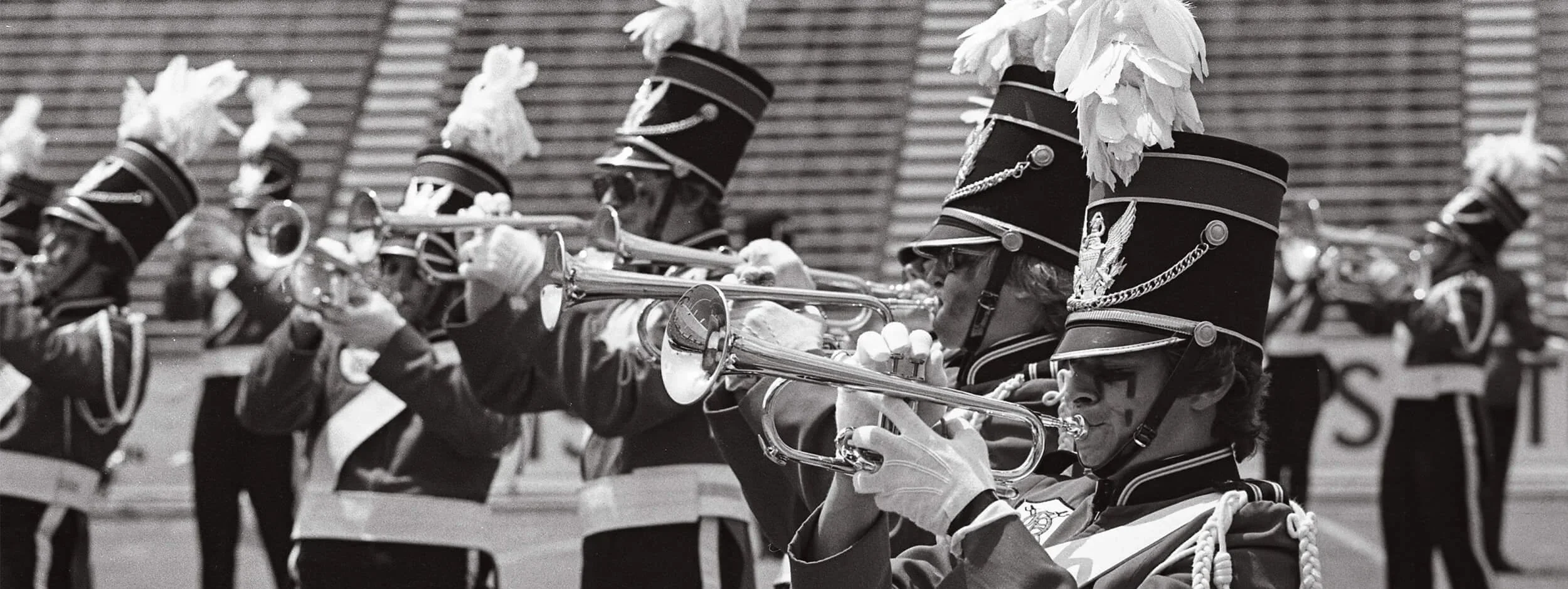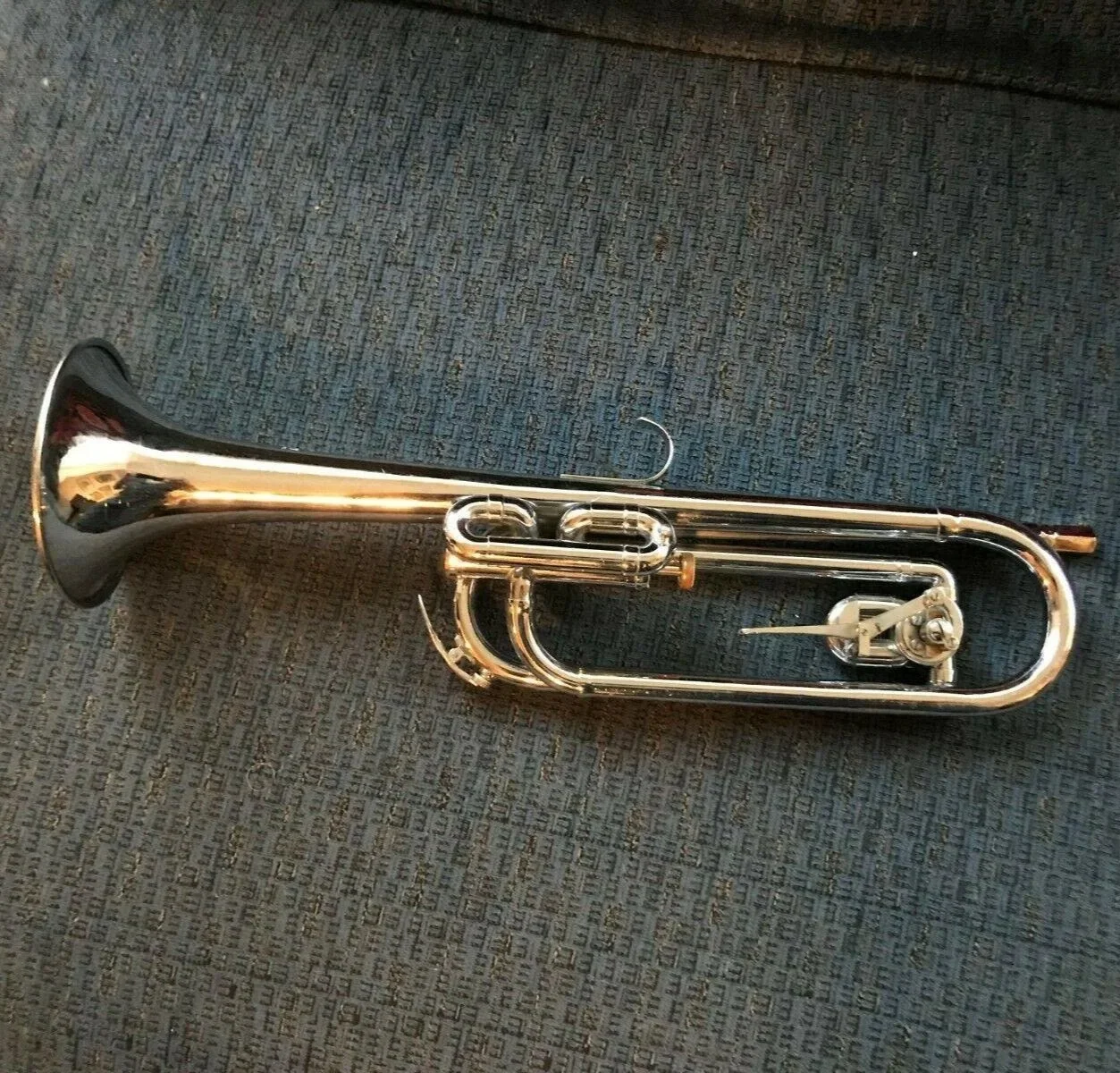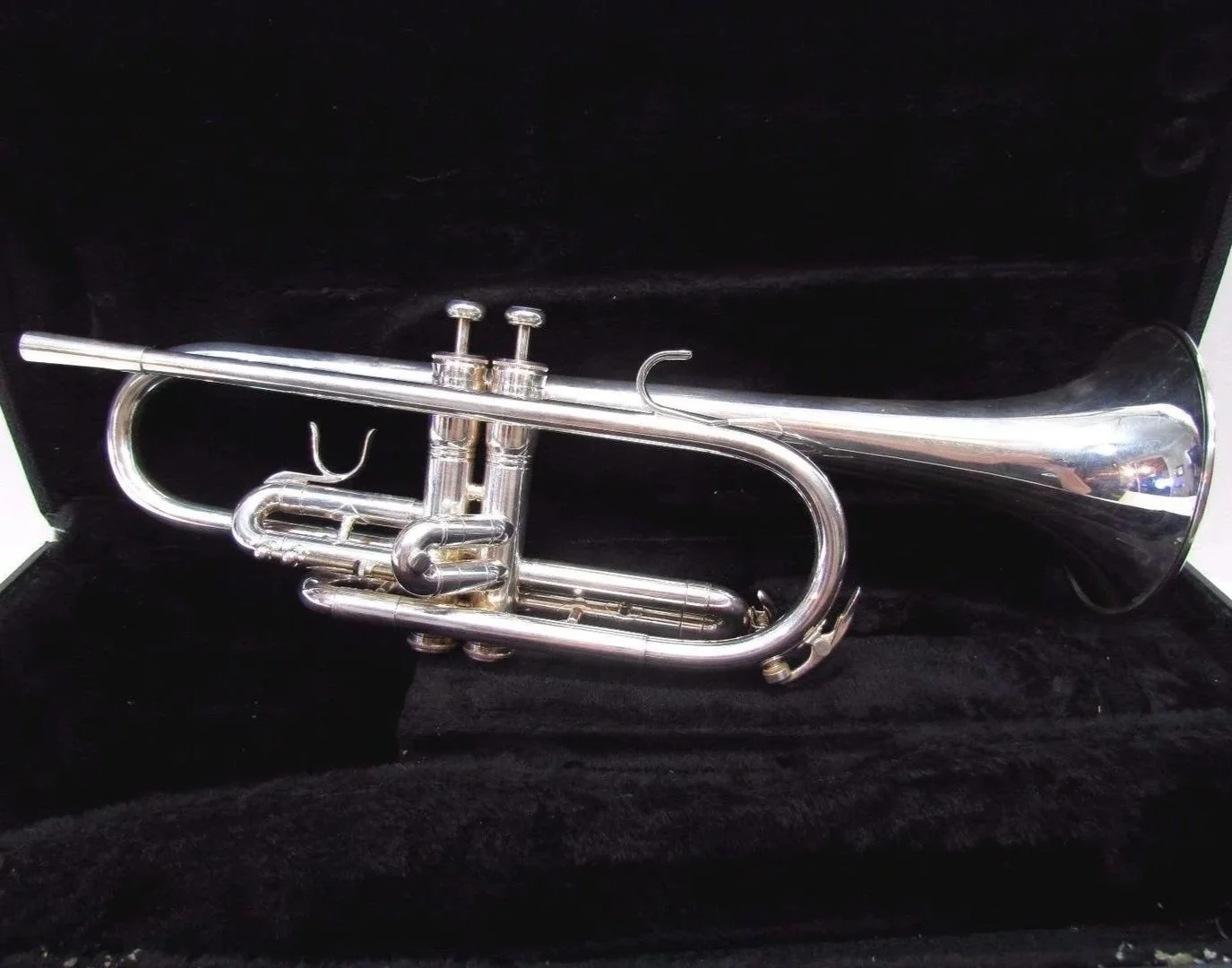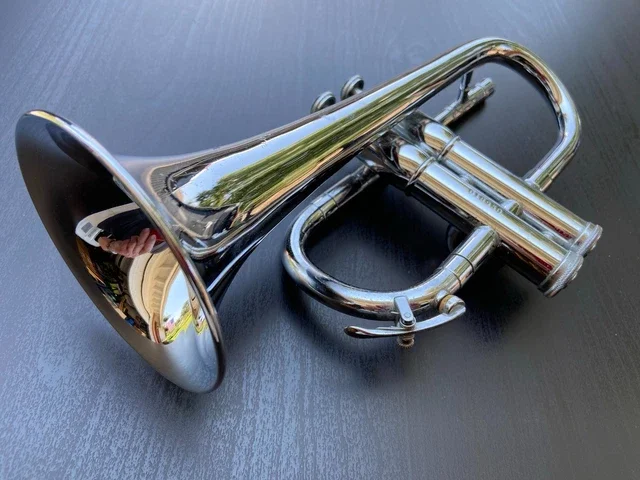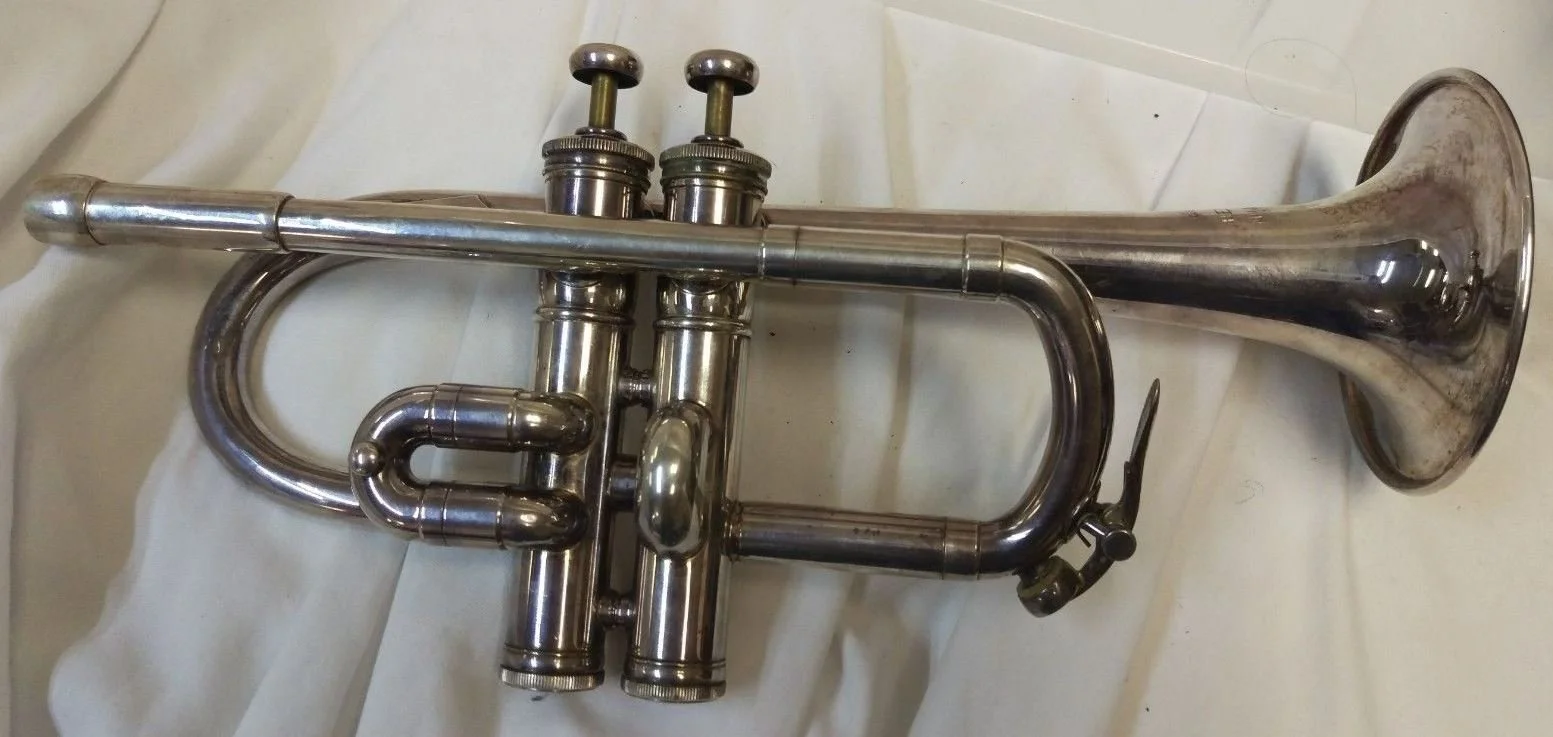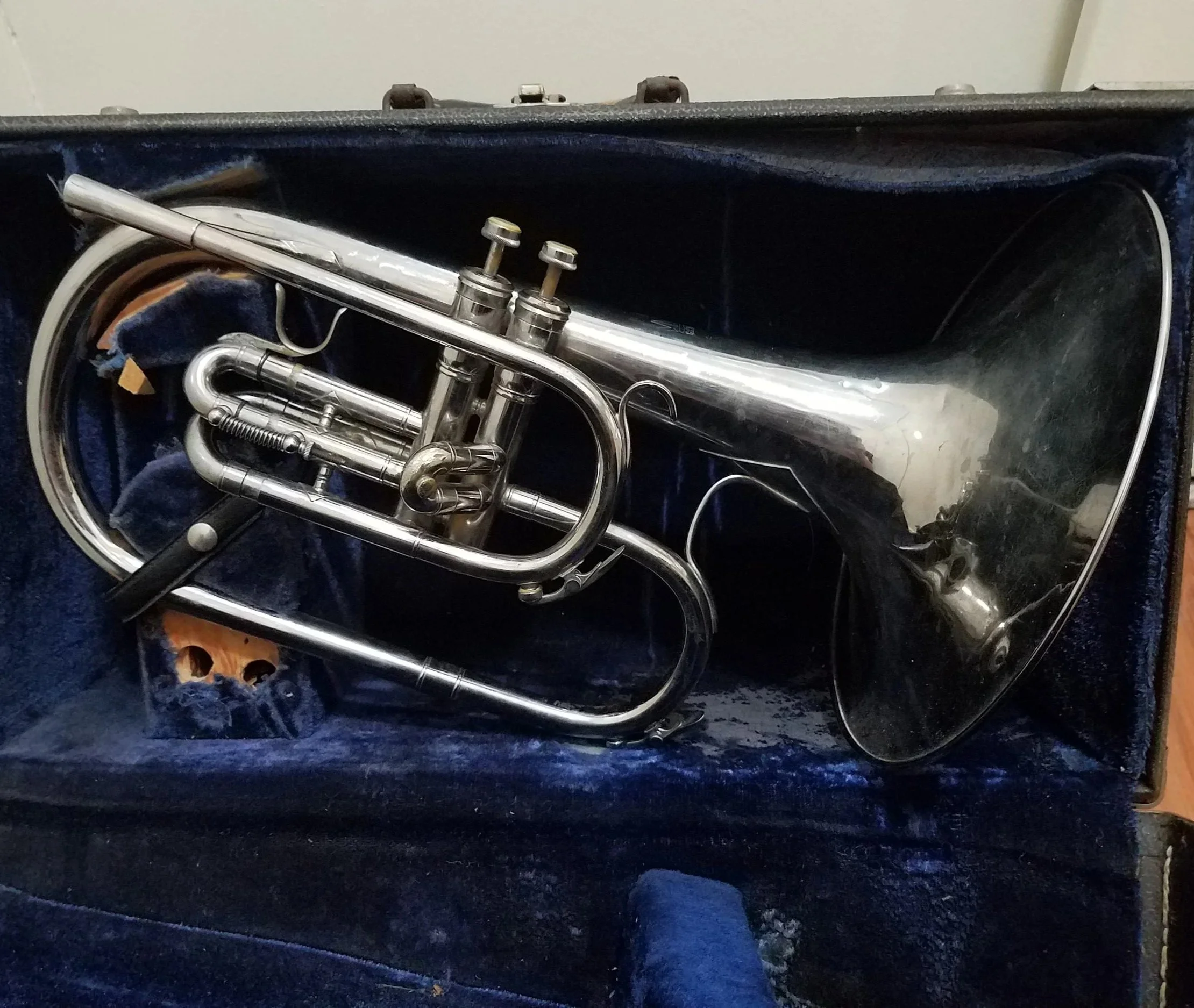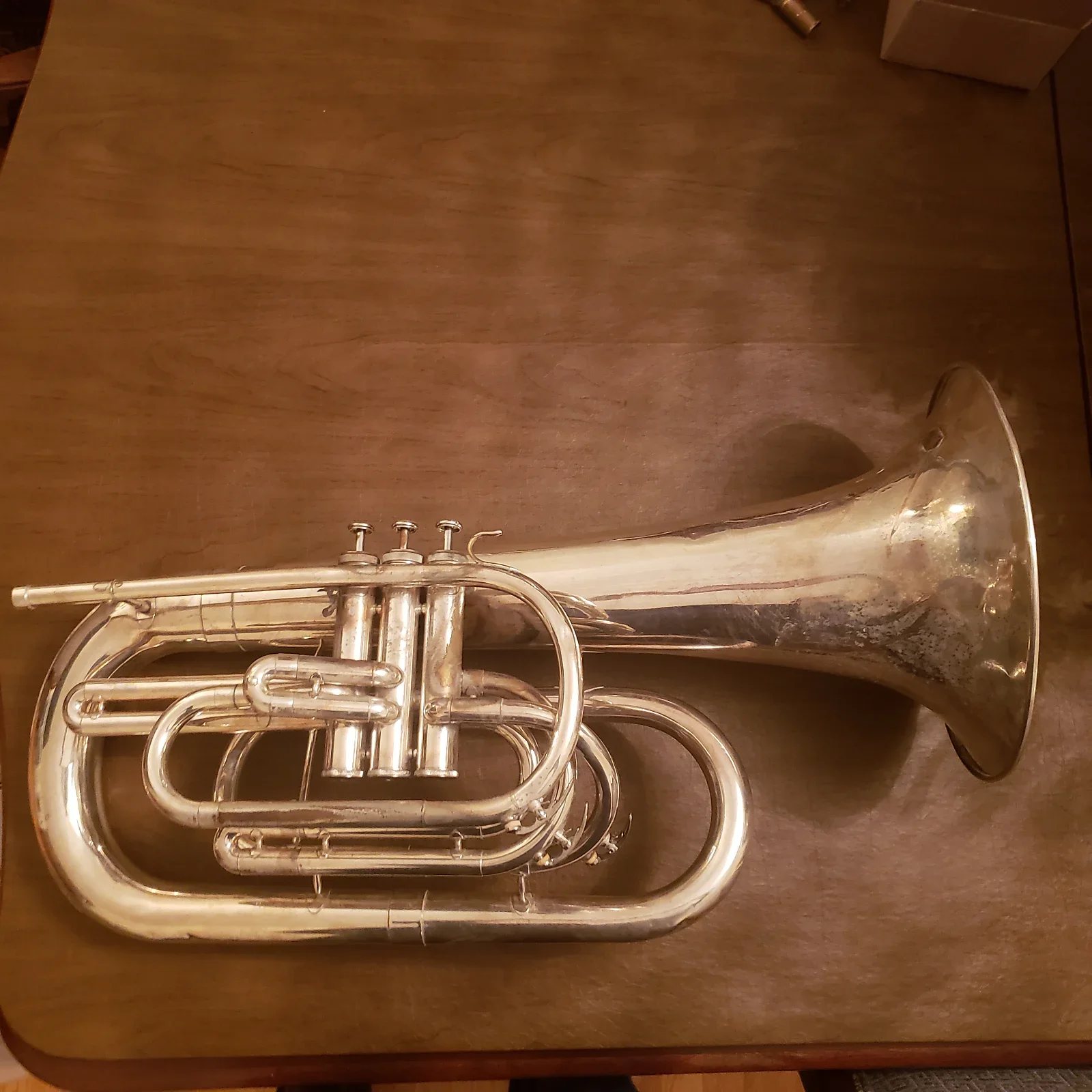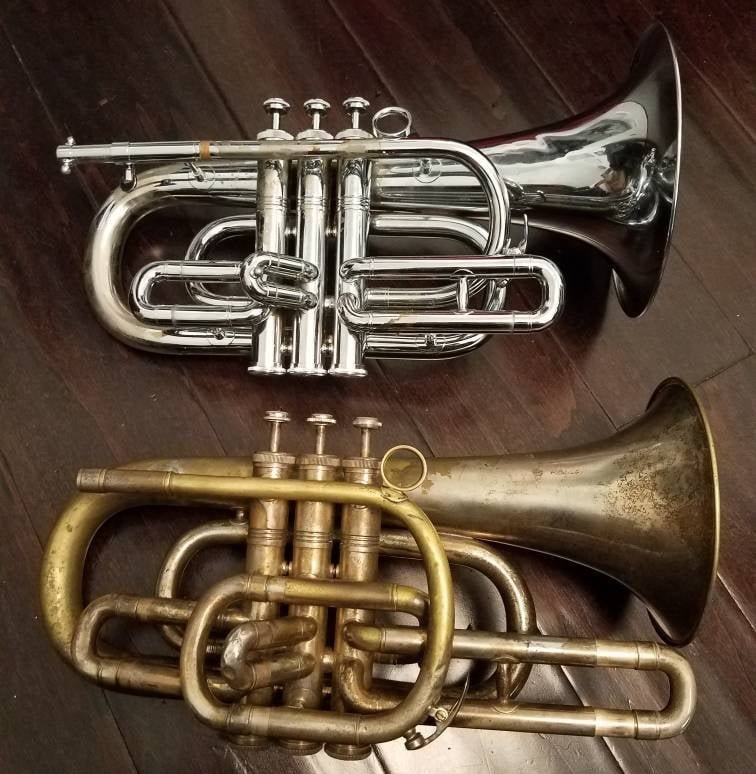G Bugles
If you’ve been wandering around my website and have noticed a fair bit of content regarding a bunch of weird bugles in G and want to know what that’s about, if you’re interested in G bugles and want to know which ones could be the most useful, or if you’re deep into the G bugle game and you just want to consume as much G bugle content as possible, this article is for you.
I’ll start with a very brief history lesson and a definition of what exactly a G “bugle” really is.
Civilian drum and bugle corps in the United States began after World War I, initially using actual valveless military bugles for the brass line. Eventually they started adding valves to the bugles, which were only allowed to be in the key of G. First came a single horizontal piston, then 1 piston and 1 rotor, 2 pistons, and finally 3 pistons. Each change came after a long and laborious process of arguing for and against The Tradition™, a drum corps pastime that continues to this day.
Along with valves, new brass voices were gradually added to the allowed instrumentation, and while many of them were not at all bugles, they were still called bugles. (For this reason I like referring to the “family” as a whole as competition bugles, rather than just bugles.) This resulted in fun names like “French horn bugle” and “trombonium bugle” that sound like they came from a Dr. Seuss book. Weird naming scheme aside, drum corps instrumentation was rife with experimentation until the year 2000, when the rules were changed to allow brass instruments in any key, instead of just G.
Drum corps is a pretty insular activity, and as a result most brass players who aren’t into drum corps don’t know much (if at all) about the G bugles. I myself never marched, and so my main interest in G bugles has always been “which of these instruments is useful outside of drum corps?”, and that’s mainly what this article is about. I have been fortunate to own a smattering of ultra-cool, ultra-rare G bugles in the past few years, and have used a few of them in very not-drum-corps environments, so I feel like I can answer that question pretty well at this point. If you are a G bugle collector, this information and advice probably does not apply to you. Let’s dive in!
Soprano Bugle
The soprano bugle was the top voice of the G hornline. These are essentially trumpets in G with an extra large bore and bell throat, and they are SCREAMERS. If that sounds appealing, you would probably enjoy a 2-valve soprano. The 2 valve horns are extremely light and extremely free-blowing, and if you’re playing screamer parts you don’t need the 3rd valve. Look for a King K-20 or Dynasty II.
However, I believe the soprano bugle’s real niche outside of drum corps is the LOW notes. Put an extra-large mouthpiece into a 3-valve soprano and you have an excellent G alto trumpet. With the huge scarcity of real alto trumpets in F or E-flat, a 3-valve G soprano bugle (which you can easily pick up online for around $200) is a legitimately useful tool for a trumpet player, or an interesting left-field choice for someone looking to add a high brass instrument to their stable.
While I would definitely recommend holding out for a 3-valve for the reasons above, an ultra-cheap 2-valve soprano is not a bad pickup either. It is fully chromatic at sounding E4 and above, which can still be useful (especially if you already have a trumpet). Just don’t spend very much!
Piccolo Soprano Bugle
These are an octave above the G soprano bugle, and are very rare. Almost all of them have two valves, making them chromatic only down to sounding E5. An interesting curiosity yet ultimately not worth looking for, especially as if one does show up for sale it will not be cheap.
Flugelhorn Bugle
Flugel bugles are not a common type of bugle, but they did see quite a bit of use in the 2-valve era. As the flugelhorn’s strength is the middle register and not the high register, I tend to think 2-valve flugel bugles are not very useful. That said, if you really want a flugelhorn and can’t find a dirt cheap one in Bb, a 2-valve G flugel bugle might be your cheapest way into a playable, nice-sounding flugelhorn. Do not show up to any kind of gig with one, but for home use and multitracking it can be a great option for the right price (no more than $200). You get the same lowest note (sounding E3) as a Bb flugel and just have 4 missing notes (Ab3-Bb3, Eb4) above that, but if you have any other mellow alto instruments that’s easy to write around. For 2-valve flugel bugles, look for the King K-30 or Dynasty II.
As for 3-valve flugelhorn bugles, they barely exist. Dynasty had one model, but it’s just a Signature 2000 Bb flugel with tubing added, which is not a good recipe. Kanstul did make at least one, but it was not a standard part of their catalog. Yamaha made a full set for the Blue Devils in 1992, but they were just modified Bb flugels. If you want a 3-valve flugel-like instrument, look to the alto bugle instead.
Alto Bugle
The alto bugle is usually a mellophone with a smaller bell, but the older ones (particularly the 2-valve Dynasty II Alto/Symphonic or the impossibly rare Dynasty III 3-valve version) are essentially big flugelhorns in G. A bit more horn-like when pushed, but otherwise all flugel. However, as the 2-valve is missing the same notes as a 2-valve flugel bugle (and is very rare), and the 3-valve I used to own is the only example I’ve seen of that model ever existing, these older (1970s) Dynasty alto bugles are not something to bet on.
The more common smaller bell mellophone type (King K-40 2-valve, Kanstul 175, later Dynasty II, later mellophone-wrap Dynasty III), is an interesting beast. With an alto horn mouthpiece, they sound like an even sweeter flugelhorn. However, they were usually designed around a marching mellophone mouthpiece, which means they can play far too flat to be usable when you use an alto horn mouthpiece. My early-pattern Kanstul KAB-175 was this way. I could only use a marching mellophone mouthpiece like it was designed for, and it played exceptionally well with that, but no longer sounded anything like a flugelhorn. Instead, the sound you get with that combination is more like a cross between mellophone and trumpet. It is certainly a unique and interesting sound, but not one that I would call useful. I’d love to hear it in a jazz combo or pop horn section, though.
Mellophone Bugle
The G mellophone bugle was originally inspired by the Conn 16E mellophoniums used in the Stan Kenton band, and the modern F marching mellophone was developed from the G mellophone bugle. With great F mellophones like the Yamaha YMP-204M readily available, is the G mellophone useful?
In my opinion, a G is useful only if you play a lot of screamer mellophone parts. I used to own a King K-50 2-valve G mellophone, the screamiest of all mellophones, and it was great fun to play screamer parts on. It is the sports car of the mellophone world. I eventually sold it because it didn’t offer enough of a difference from my other mellophones, but I had a ton of fun with it. If you can find a K-50 for a great price and want to give it a shot, I can guarantee you’ll have a great time with a K-50 or a 3-valve G mellophone (Dynasty or Kanstul) if you like playing very high on mellophone.
What I would not recommend is buying a G mellophone as your only mellophone. Get a good F marching mellophone, like a cheap King 1120 from eBay, so that you can have a workhorse that you can read existing mellophone or horn parts with. Then, if you want, pick up a G mellophone (2 or 3 valve) to add some more brightness and high note security to your mello arsenal.
Meehaphone
Kanstul MFL meehaphone
The meehaphone is the most famous of the weird and ultra-rare G bugles. Made for Kanstul for the Blue Devils in 1987, the meehaphone is essentially a bell-front descant horn in G with 2 valves. I was fortunate enough to own the only known meehaphone not in a museum for a while, and while it was very cool it was not very useful. The instrument’s forte is its middle register, with the high register being weak and unstable. But since it only has 2 valves, that middle register is only fully chromatic for less than an octave! A 3-valve meehaphone built from parts would be interesting, but if you’re doing that you’re in pretty deep.
French Horn Bugle
The French horn bugle was one of the standards of the DCI hornline in the 2-valve era, partly because it unlocked a lot of the missing pitches the mellophones had. Because it was built an octave lower than other mid-voice bugles, it was the only kind of bugle that really never needed 3 valves on the field. The lowest chromatic pitch (sounding E3) on a 2-valve “Frenchie” is far below what you would see in a typical drum corps French horn book.
However, because the French horn bugles were nearly as long as a single F horn, they were very easy to crack notes on while running across a football field. But are they useful off the field?
If you’re playing a live gig on multiple brass instruments where you are playing into a mic and need to cover some French horn parts, a marching horn is exactly what you need as the bell points the right way for the mic. But Bb marching horns exist and are plentiful, so why go for the G? Most of the time I would say you don’t need to, especially as 2-valve Gs don’t typically go for any cheaper than 3-valve King Bbs on eBay. However, the G really does sound very close to a concert horn, and the Bb is not as close. So if you want a really convincing horn sound for a mic placed in front of you, the G French horn bugle (King K-60, Dynasty II) could be your best bet.
While 2 valves is more than enough for field use, if you happen to come across one of the enormously rare 3-valve G French horn bugles (Kanstul KHB-185, Dynasty III) at a good price, that 3rd valve is obviously nice to have. That said, on the only gig I’ve had where I would have used my G French horn bugle if I had it at the time, I actually would have only needed 2 valves.
Low Alto Bugle
Kanstul low alto bugle
The low alto bugle is one of the oddest and rarest G bugles out there. It was made by Kanstul at the start of the short 3-valve era, and so few were made (6 total) that it didn’t even get a model number. It is essentially a Kanstul KHB-185 3-valve G French horn bugle with a trumpet shank, which sounds like it would just be a 185 but worse. However, the truth is much more interesting. Many kinds of mouthpieces will fit (trumpet, mellophone, alto horn, small trombone, French horn w/adapter), and the horn works very well with ALL of them. Each mouthpiece gives it a unique sound, like a cross between a French horn and whatever type of mouthpiece it is. Out of all the G bugles I’ve owned, the low alto might have the most potential. But since only 6 were made and at least 3 are spoken for, you’re very unlikely to come across one. If you want something like this, you might look into a Holton MH-100/101 Bb marching horn, which also has a trumpet leadpipe for some reason.
Trombonium Bugle
Dynasty II trombonium bugle
The award for the silliest name easily goes to the trombonium bugle, and it is also one of the silliest looking. It was made by Dynasty in 2 and 3 valve versions and small and large bells, and I can’t find any reason to recommend one over a normal Bb valve trombone or flugabone. They are also extremely rare, so you probably won’t have that choice to make anyway.
Cellophone
The cellophone is another impossibly rare G bugle. Essentially a Dynasty flugabone in G, only 4 2-valve models were made, all for the Phantom Regiment. However, 3-valve Dynasty III models were also made for the European market, but only 4 of those are known to exist. You’d have much better luck taking a Bb flugabone from King or Dynasty and lengthening it to G, or just playing a Bb flugabone.
Baritone Bugle
This is the low brass G bugle that you want. Originally called a “bass baritone” to distinguish it from the older and smaller type of baritone bugle, this kind of baritone bugle was the standard type of low brass in DCI hornlines from its inception until the end of the G bugles (at which point it was just replaced by the same thing in Bb). Most of them have 2 valves, and in my opinion they are not worth it for someone looking to use it in non-drum corps situations. You can get used Bb marching baritones very easily, and they will be much more useful. However, if you can find one of the much less common 3-valve G baritone bugles (Kanstul KBB-190, Dynasty III, Dynasty M371) for an affordable price, it can be an interesting purchase.
As your only low brass instrument for home use, the 3-valve G bari would be a nice option as it can play as high as a Bb instrument but can also play chromatically down to Db2. However, I would usually only recommend purchasing a G baritone as a second instrument to a Bb instrument (regardless of type), and it doesn’t bring THAT much new to the table. It has a nice fat sound that is different enough to a Bb marching baritone that it could be interesting to own both, but between baritone and euphonium I don’t think there’s much of a need for that G baritone sound. I think the most sensible use would be if you don’t want to put down the money for a 4-valve euphonium (and/or no $500 Yamaha YEP-321s are for sale at the time), but want something that can play lower than your 3-valve Bb instruments. But it would have to be a very good price on the G baritone, like $300 or less.
Euphonium Bugle
The G euphonium bugle is the baritone bugle’s big brother, and is one heavy beast. Pretty much everything I said about the baritone bugle above also applies to the G euph. I will say that Bb marching euphoniums are not nearly as common to find used for cheap as Bb marching baritones, so if you need a bell-front euphonium to play into a mic and happen to find a G euph bugle for cheap it could be a good solution. That said, G euphs are also not as common as G baritones (ESPECIALLY the rare 3-valve models by Kanstul or Dynasty), so it would have to be a lucky situation.
Contrabass Bugle
Generally, contrabass bugles are just Bb tubas that point forward and are crooked down to G. A 3 or 4-valve G contra is a cool beast, but not a cheap or useful one. In my opinion the only reason to buy a G contra would be if it was an older piston/rotor or 2 piston model being sold for nearly nothing, that you could get converted to a concert tuba with a front-action valve set in the same bore that you happen to have lying around. Otherwise, a normal tuba is a much better purchase.
Closing Thoughts
Sadly, the door is nearly shut on the G competition bugle. G bugles were quickly phased out of DCI competition after the any-key rule change in 2000, and the list of groups that still use G bugles is not a long one. The most notable is the United States Marine Band Commandant’s Own Drum & Bugle Corps, which very recently moved from 2-valve Kanstuls to 3-valve BACs. Other than that, there are some alumni and lower-level junior corps that are still on G, as well as a handful of small G-faithful corps in Japan, such as the Yokohama Scouts.
The only place to buy a new G bugle is from BAC in Kansas City. BAC acquired the Kanstul G bugle tooling when Kanstul shut its doors in 2019, which is why they made the new bugles for the Commandant’s Own. They do advertise the G bugles on their website catalog, but they price them at nearly twice what Kanstul did, making them far out of reach for most people who might be interested in one. Additionally, they only offer 4 out of Kanstul’s 10 bugle models, so if you want anything other than a soprano, mellophone, large baritone, or contra, you are probably out of luck.
Fortunately, the common types of G bugle were made in large quantities to outfit all the corps’ hornlines, so there is no shortage of used soprano, mellophone, French horn, baritone, and contrabass bugles to be found. Additionally, as they are all essentially obsolete and only desirable by DCI alumni and G bugle collectors, they usually go for very affordable prices. The 3-valve horns and less common types (alto, flugelhorn, euphonium) are harder to find, but if you are patient it is still doable. If you are diligent, you may even come across one of the ultra-rare models for a very low price. There are still unaccounted-for examples of nearly every kind of bugle ever made out there waiting to be found.
Alto Bugle
“Alto bugle” typically refers to a type of competition bugle pitched in G for use in drum and bugle corps. Of the four main types of mid-voice bugle used in drum corps history (mellophone, French horn, alto, flugelhorn), the alto bugle is probably the rarest type. The general blueprint for an alto bugle is a mellophone but with a much smaller bell flare, but each model of alto bugle tackled that blueprint differently. I would group alto bugles into two main camps, and an excellent demonstration of these camps are the two alto bugles DEG/Dynasty had in their lineup concurrently.
On the left is a Dynasty II “Symphonic” alto bugle, which was built for Dynasty by Willson, the renowned Swiss brass maker. This is the older style of alto bugle, and the Symphonic especially is really just an extra-large flugelhorn in G. With a British-style alto horn mouthpiece it has a huge, dark flugelhorn sound, that’s a bit more horn-like when pushed. These came from the factory with a Bach 12 alto horn mouthpiece, though I don’t know if that’s what the drum corps actually used with them on the field. In the old days alto bugles like these were sometimes called “alto sopranos”, and they were used on the 3rd soprano bugle part to fatten up the sound. Of course, this earlier type of alto bugle is a close cousin to the flugelhorn bugle, whereas the later mellophone-based type diverged more and allowed the two voices to be distinct, especially as the flugel bugles were built using Bb flugelhorn bodies. I’d be interested to know if any corps ever used flugels and altos at the same time.
Many (most?) alto bugles had 2 valves, as that was the rule in DCI until 1990. But there are a few 3-valve alto bugle models as well.
Dynasty III alto bugle (late 1970s): Likely the earliest 3-valve alto bugle to be made. As DCI was over a decade away from legalizing 3 valves, the complete Dynasty III bugle line was made (mostly by Willson) for the European market.
Dynasty late-pattern alto bugle: This one was based on Dynasty’s existing mellophone design rather than a separate one, and was made in-house instead of by Willson. (The link calls it a flugelhorn bugle, but the Dynasty 3-valve flugelhorn bugle was a different beast made by slapping longer slides on a DEG Signature 2000 Bb flugel.)
Kanstul KAB-175 (pre-1993, early pattern): The early production Kanstul alto bugle design resembles a smaller King 1120 marching mellophone, and as both instruments were designed by Zig Kanstul, is probably where the King design originated.
Kanstul KAB-175 (late pattern): Later production examples used a totally new wrap that lasted until Kanstul went out of business in 2019.
At one time I owned the only Dynasty III alto bugle I have ever seen. I haven’t been able to find any record of another individual example on the Internet. As none were made for the US domestic market, it may be the only one in the country. But rare G bugles have a funny tendency to show up in the weirdest places, so there could be others hiding in the States. I bought mine from Canada.
The following picture shows the Dynasty III, and also my DEG 1220 alto cornet in F for comparison, also made by Willson around the same timeframe and also very rare (but much more common than the Dynasty III!). It’s easy to see the family resemblance between the two instruments, even though they actually sound quite different.
Dynasty III G alto bugle (top) and DEG 1220 F alto cornet (bottom)
As the names imply, the alto bugle sounds like a flugelhorn, while the alto cornet sounds like a cornet. The alto bugle has a fat, dark flugel sound; the alto cornet has a brighter, leaner cornet sound. Both instruments play very well.
I also used to own an early pattern Kanstul KAB-175.
This instrument had a fabulous flugelhorn sound with a tenor horn mouthpiece (the same one I used in the Dynasty alto bugle and alto cornet). It was smoother and a shade darker than the Dynasty, and was a really refined sound. Which is not to say the Dynasty was rough; compared back to back with my Couesnon flugelhorn the Dynasty sounded quite close, just with a bit more beef in the sound. But the Kanstul took it a step further and makes the sound a little rounder and sweeter still.
Unfortunately, with this mouthpiece the instrument also played quite flat with the tuning slide all the way in. This is likely because it was designed around the classic Mello 6 marching mellophone mouthpiece. I have one of those, and putting either it or my Hammond 5MP marching mello piece into the Kanstul fixed the pitch and felt like the right match for the horn size-wise…but also entirely lost that lovely velvet flugelhorn sound. With the Mello 6 it predictably sounded like a more focused, direct marching mellophone. Very bright and trumpety, but much fatter than any trumpet (or G soprano bugle). There may be a niche for this sound, but I couldn’t find it and the big flugelhorn sound is really what I want in an alto bugle, so I eventually sold this instrument.
Physically, the Kanstul was fantastic. The valves were the best I’ve ever owned in any kind of brass instrument…lightning fast and whisper quiet. The instrument itself felt like it weighed nothing in the hand, owning to its light weight and great balance. I’m sure it would be a pleasure to march with, as instant horn snaps and moves are a piece of cake. The left hand grip is comfortable, there is a 1st valve slide kicker…it has everything you want. It feels like a massive leap forward in alto bugle design from the Dynasty, although the Dynasty’s super-compact form factor is definitely convenient. It is a shame then that the Kanstul doesn’t work out of the box with the tenor horn mouthpiece that the Dynasty happily accepts without issue; it could be that that early alto design was based around a larger, more tenor horn-like mouthpiece.
Although I never found a real use for the Kanstul and thus sold it, it’s one of the most enjoyable brass instruments I’ve ever played and I do miss it.
To hear the Kanstul meehaphone, Dynasty III alto bugle, and Kanstul KMB-175 alto bugle, check out this video:
The Marching Alto
Just as the mellophone bugle in G begat the marching mellophone in F, the alto bugle in G begat the marching alto in F. And as rare as the G alto bugle is, the F marching alto might be even rarer. Unlike the alto bugle and its limited use in DCI drum corps (especially in the 2-valve era), I know of nobody who ever fielded a line of marching altos. (If your high school or university marching band did, I’d love to know about it!)
These are the types of marching alto I know of:
Kanstul KMA-275 (late model): This is the F version of the late-pattern 175 alto bugle. I have yet to find evidence that Kanstul ever made an F marching alto version of the early pattern KAB-175 G alto bugle, or that any other maker made a smaller-bell version of their mellophone. It could be the only purpose-built marching alto ever made.
Nirschl E-102 mellophone: This horn wasn’t intended to be an actual marching alto, it was just Nirschl’s poor attempt at making a marching mellophone. It also works no better as a marching alto as it does as a mellophone…in fact, there is nothing it is good at. But it technically counts?
Andalucia AdVance Series Alto Horn: This is a current-production instrument in F, based on the Kanstul Meehaphone. The meehaphone was a 2-valve instrument used from 1987-1991, and while it was built around a French horn bugle bell and was essentially a field descant horn in G, it successfully fulfilled the same role as an alto bugle (darker sound than a mellophone, but more projection than a flugelhorn).
Kanstul 270 "marching tenor horn”: This was a similar sort of thing to the Andalucia above - essentially a 3-valve meehaphone in F. It wasn’t sold for very long, but they are out there!
As an aside, although they are not really marching altos, there are also bell-front alto horns, aka “solo altos”. These are mostly instruments from turn of the 20th century meant for alto horn soloists and shaped like large cornets. They are usually in E-flat and have much smaller dimensions and a smaller sound, as they are based on concert alto/tenor horns rather than marching mellophones. The Swedish maker Lars Gerdt had a marching tenor horn in E-flat listed on their website until recently.
Anyway, I recently acquired a Kanstul KMA-275 late pattern marching alto in F. It’s the first one I’ve ever seen in the wild; until it popped up for sale locally I had only ever seen the picture of it on Kanstul’s website all the way back in 2002.
The product page for the KMA 275 from Kanstul’s website circa 2002 (via the Wayback Machine).
My KMA 275.
While I knew the design had radically changed since the early pattern design, I assumed that this instrument would play pretty much like my KAB-175 did, just in F. But it actually plays quite a bit differently. Although it lacks the uniquely sweet sound the KAB-175 had with a tenor horn mouthpiece, the KMA-275 is actually usable with a tenor horn mouthpiece as it plays up to pitch without issue. In fact, the KMA-275 is happy with most mouthpieces you could throw at it.
Rather than describe all of these, here’s a short demo of some of the mouthpieces that work well:
I have to admit, although this instrument is very cool and as well-built and easy to play as you would expect, I would really love to find an early-pattern version of the 275. The KAB-175 was one of the most fun, satisfying instruments I’ve ever played and while this KMA-275 is excellent, it hasn’t made me unwilling to put it down yet. We’ll see if I get there.
Until recently I couldn’t find any existence of the early pattern mellophone/alto design in F at all, and I wondered if Kanstul only started making things other than G bugles after the late-pattern design was introduced. But an early-pattern Kanstul F mellophone recently showed up on eBay (for way too much money, or else I would have bought it already), so the early pattern in F has been proven to exist. But I am still in search of evidence of the smaller-bell 275 F marching alto in the early pattern.
The early pattern Kanstul 280 F marching mellophone from the eBay listing - stenciled as a Besson.

